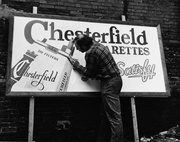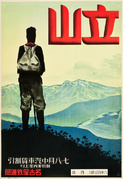
It only takes a few inches of paper to conjure entire worlds: A hike in the Polish countryside; a smoke-filled Japanese jazz club; or an astronaut’s view of a Russian space station. Each of these tantalizing scenes once adorned the sides of ordinary matchboxes, deftly illustrated with a few simple shapes and bright colors. Though often overlooked, vintage matchbox labels are treasures of modern design, thanks to the skills of anonymous artists who created these elegant ads that fit in the palm of your hand.
“Matchbox labels offered the perfect canvas for efficient, modern advertising.”
Jane McDevitt discovered the beauty of vintage matchboxes via eBay, where her obsession with beautiful typography and well-designed ephemera led her to the paper labels. Though she doesn’t really consider herself a “phillumenist,” or someone who collects matchboxes, McDevitt’s collection now runs in the thousands, many of which are available for viewing on her personal Flickr page. McDevitt also gravitates towards other bits of ephemera, like British wrestling posters and camping-club pennants, but in terms of sheer number, the matchbox labels are the clear winner. “I live in quite a small apartment, so I have to curb these things,” says McDevitt, “but the matchboxes are great because they all fit into one small box.”
A British chemist named John Walker invented the first friction match in 1827, using small splinters of wood tipped with sulphur and phosphorous. The first safety matches (which had to be struck against a specially prepared surface) were developed by Edvard Lundström in Sweden around 1853. Lundström joined forces with his brother Carl Frans Lundström and quickly developed a standardized package for matches—a cardboard box with an inner drawer—and coated the outer edges with a striking surface.

Top and above: Russian matchbox labels use graphic forms to illuminate subjects ranging from space travel to the 1964 Tokyo Olympics.
Sweden soon dominated the global match industry, but the advertising potential of matchboxes was realized in America: Supposedly, in 1892, the manager of the Mendelssohn Opera Company in New York had the actors hand-letter matchbook covers with details of their show’s run. Diamond Match salesman Henry C. Traute got wind of the story and thought this guerrilla marketing tactic might appeal to major corporations, too. Traute had an advertisement for Pabst beer printed at matchbook dimensions, and took the sample to the company’s headquarters in Milwaukee, landing an order for 10 million Pabst matchbooks.
This creative advertising method spread like wildfire—from beer companies and bars to high-end hotels and department stores. Following the stock market crash of 1929, the Swedish company Svenska Tändsticks Aktiebolaget (STAB), which evolved from the Lundström’s original business, no longer dominated the industry, and regional producers stepped in to create their own match labels. Most of McDevitt’s labels were made in Eastern Europe and Japan, and judging from their designs and a few scattered dates, her collection spans from the 1920s up through the 1980s. For most of that period, match production was booming as smoking became a universal pastime, but in the late 1970s, 90 percent of the matchbox market suddenly disappeared with the introduction of cheap, disposable lighters.
While she’s curious about the origins of her labels, McDevitt is more interested in their use of shape, color, line, and type. Because of limited printing technology and their small size, matchbox labels offered the perfect canvas for efficient, modern advertising. With such constraints, less truly is more. In fact, the walls of McDevitt’s website-design business, Maraid Design, are hung with enlarged matchbox advertisements, and she suspects their graphic pop has informed her own projects. “I do veer towards bright, solid colors if I can get away with it,” says McDevitt. “I think I’ve spent so long looking at these labels that there must be some sort of influence.” Eventually, McDevitt hopes to publish a book of the most exceptional designs in her collection.
Matchbox labels from Eastern Europe often featured government-owned businesses or public health and safety messages—yet despite their bureaucratic messaging, the designs incorporate a bright, clean modernism. As McDevitt asked on her blog, “Why did this area of the world embrace modern design and imagery when many countries, including Britain, still preferred the Victorian aesthetic?” By adopting the Mid-Century Modern forms, these socialist states projected the brightest of futures, even in a time of Cold War tensions. The labels capture a time of transition, carefully balancing a reverence for nature and family with Space Age technology and urban living.
But McDevitt’s Japanese labels, which come from a slightly earlier era, also record a culture in flux. Some subjects, like hot springs and tea houses, were staples of Japanese industry; others like jazz bars and European bakeries were newly arrived from overseas. The blend of traditional Japanese imagery and Westernized Art Deco is what makes these ads so interesting: Geishas and flappers appear like two sides of the same coin.
Today, in an era of digital billboards and smartphone apps, it’s refreshing that such eye-catching graphics were made for a cheap commodity like matches—contemporary designers take note.
(For more amazing match labels, check out the books “Matchibako: Japanese Matchbox Art Of The 20s & 30s” and “Close Cover Before Striking: The Golden Age of Matchbook Art,” or visit the Match Museum in Jönköping, Sweden.)



































 Artisanal Advertising: Reviving the Tradition of Hand-Painted Signs
Artisanal Advertising: Reviving the Tradition of Hand-Painted Signs
 Playing With Matches: Sexy, Silly 1930s Ads That Went Up in Smoke
Playing With Matches: Sexy, Silly 1930s Ads That Went Up in Smoke Artisanal Advertising: Reviving the Tradition of Hand-Painted Signs
Artisanal Advertising: Reviving the Tradition of Hand-Painted Signs Mysterious Railway Posters Depict the Dreamy Allure of Deco-Era Japan
Mysterious Railway Posters Depict the Dreamy Allure of Deco-Era Japan MatchbooksMatchbooks have been around since 1892, when Joshua Pusey patented the idea…
MatchbooksMatchbooks have been around since 1892, when Joshua Pusey patented the idea… Matchbox LabelsBecause all matchboxes are essentially the same, brand-centric advertising …
Matchbox LabelsBecause all matchboxes are essentially the same, brand-centric advertising … TobaccianaTobacco became popular in Europe in the 1600's, after traders brought back …
TobaccianaTobacco became popular in Europe in the 1600's, after traders brought back … Mari Tepper: Laying it on the Line
Mari Tepper: Laying it on the Line Nice Ice: Valerie Hammond on the Genteel Charm of Vintage Canadian Costume Jewelry
Nice Ice: Valerie Hammond on the Genteel Charm of Vintage Canadian Costume Jewelry How Jim Heimann Got Crazy for California Architecture
How Jim Heimann Got Crazy for California Architecture Modernist Man: Jock Peters May Be the Most Influential Architect You've Never Heard Of
Modernist Man: Jock Peters May Be the Most Influential Architect You've Never Heard Of Meet Cute: Were Kokeshi Dolls the Models for Hello Kitty, Pokemon, and Be@rbrick?
Meet Cute: Were Kokeshi Dolls the Models for Hello Kitty, Pokemon, and Be@rbrick? When the King of Comedy Posters Set His Surreal Sights on the World of Rock 'n' Roll
When the King of Comedy Posters Set His Surreal Sights on the World of Rock 'n' Roll How One Artist Makes New Art From Old Coloring Books and Found Photos
How One Artist Makes New Art From Old Coloring Books and Found Photos Say Cheese! How Bad Photography Has Changed Our Definition of Good Pictures
Say Cheese! How Bad Photography Has Changed Our Definition of Good Pictures Middle Earthenware: One Family's Quest to Reclaim Its Place in British Pottery History
Middle Earthenware: One Family's Quest to Reclaim Its Place in British Pottery History Fancy Fowl: How an Evil Sea Captain and a Beloved Queen Made the World Crave KFC
Fancy Fowl: How an Evil Sea Captain and a Beloved Queen Made the World Crave KFC
Impressive what was conveyed with minimal imagery on such limited space and accomplished with lithographic printing. Part of the visual impact is due to the image being presented on an isolated miniature ‘canvas’. A novel venue that allowed and showcased the innovative design. On a page with visual competition, the impact would be severely diminished.
Hi Everyone!
I am very interested in Japanese advertising images of the very late Taisho and early Showa eras (essentially late 1920s through 1942) – such as matchbox designs, hoardings,
magazine and film images – particular images that related to nightlife, travel and ‘modern’ lifestyles.
I need some references to follow to guide me.
Thank you!
I got alot of matchbox of my mom from poland 1950-1970